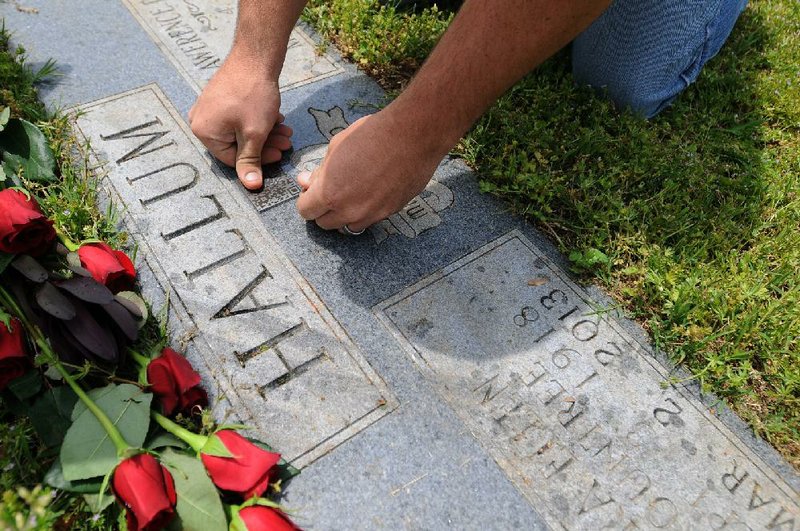SPRINGDALE - You can only tell so much of someone’s life story on a grave marker.
But now a Northwest Arkansas monument company is using new technology to paint a more detailed picture of those who have passed away.
Springdale-based Emerson Monument Co. is offering Quick Response codes etched on small metal plates that can be affixed to grave markers. By using a smartphone application, the code takes visitors to a website of the client’s choice where visitors can post photos, stories or videos of the deceased.
Quick Response codes were invented by a Japanese car manufacturer in 1994. Today they are widely used in advertising and marketing.
Alison Raymer, CEO and co-owner of Emerson Monument, said her job is telling stories in stone but the codes, with their abilityto link to so much additional information, offer a chance to provide more detail. She and her husband bought the company, which was started in 1914, six years ago.
“Telling the story is our primary goal,” she said.
For a $155 fee, Emerson Monument will etch and affix the code to a monument within 120 miles of Springdale. The company also has the ability to etch the code directly into some types of new monuments. There are no subscription fees and no standard templates families are required to use.
Scott Neal, a former president for the suppliers division of the North American Monument Builders Association, said the first Quick Response code was used on a memorial in the U.S. in 2011. He said during 2012, the industry began to take an interest in the technology and it’s being slowly adopted nationwide.
He said a unique aspect of the technology is it allows older memorials to be updated with new material.
“It can be added after the fact,” Neal said.
The monument company has been offering the codes for about two months and Awynne Thurstenson, who lives south of Siloam Springs, was one of the first customers to choose the feature. Last week, the code plate was placed on her parents’ grave marker at Cookson Hills Cemetery, just south of Kansas, Okla., a little west of the Arkansas border.
Thurstenson’s father Lawrence Hallum died in in March 2009 and her mother, Ellen, died in March of this year.
Thurstenson said she often would look at gravestones, see a birth date and a date of death separated by a dash and wonder about the life stories those dashes represented. She said using the Quick Response codes help to fill in the blanks.
The code on the Hallums’ memorial takes visitors to a website where they can see a black-and-white photo taken in 1941 of the Hallums as a young couple. Lawrence, along with Ellen who is holding their first child, Patricia, stand in front of a house Lawrence built for his little family.
The website includes stories from both Ellen’s and Lawrence’s past, stories of the family, the Cookson Hills community and the Hallums’ obituaries. There is even a place folks can leave comments for the family.
“My parents laughed their way though life,” she said. “They always chose to be cheerful and positive.”
Thurstenson said she liked the flexibility the system allowed her to tell her parents’ stories as she saw fit, beyond the standard marker.
Thomas Wallace, information technology program coordinator for the University of Arkansas at Little Rock, said that’s what Quick Response codes do best.
“It’s a great technology to supplement information,” he said.
He said the use of Quick Response codes on memorials was intriguing and it should work well for its intended purpose. He said it will still require families to keep links current and update the data when needed or the “information footprint can fade.”
Another concern is that eventually the codes will become outdated. He noted the technology is at its zenith now but it likely be replaced with near-field communication, which uses radio frequency identification technology to connect to smart phones and other devices.
“All technology has a natural progression,” Wallace said.
Jeff Smith, president-elect of the Arkansas Funeral Directors Association, said to the best of his knowledge Emerson Monument is the only company in the state offering the QR code upgrade. He said it might not be seen as a desirable addition to some older customers, who often are the ones making decisions about funerals nowadays, but younger customers likely will embrace the technology.
“I think it will be helpful going forward,” Smith said.
He said the the codes would fit in well with recent industry trends toward online guestbooks and obituaries, and the price point seemed reasonable.
Emerson Memorial’s Rayner said the business will always focused on stone memorials but the QR code technology is an important addition to the company’s services.
“They tell the story,” she said of stone markers. “But now you can get the rest of the story online.”
Business, Pages 19 on 05/13/2013

